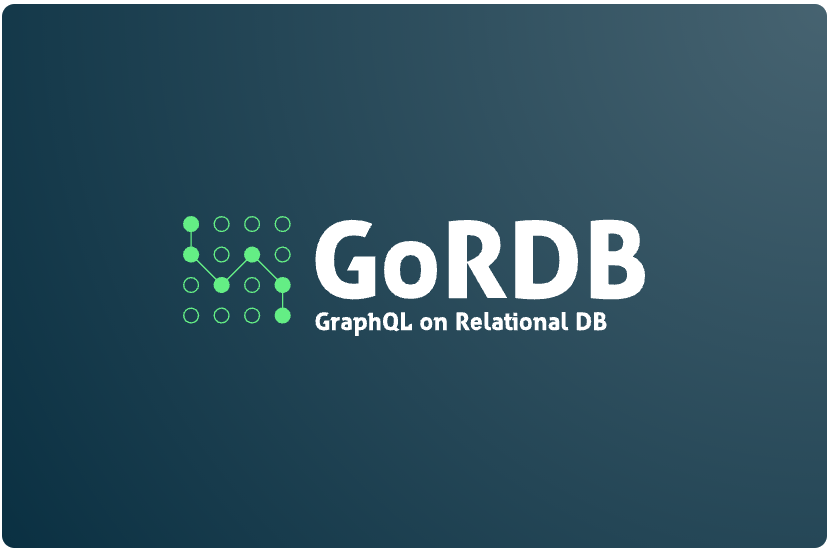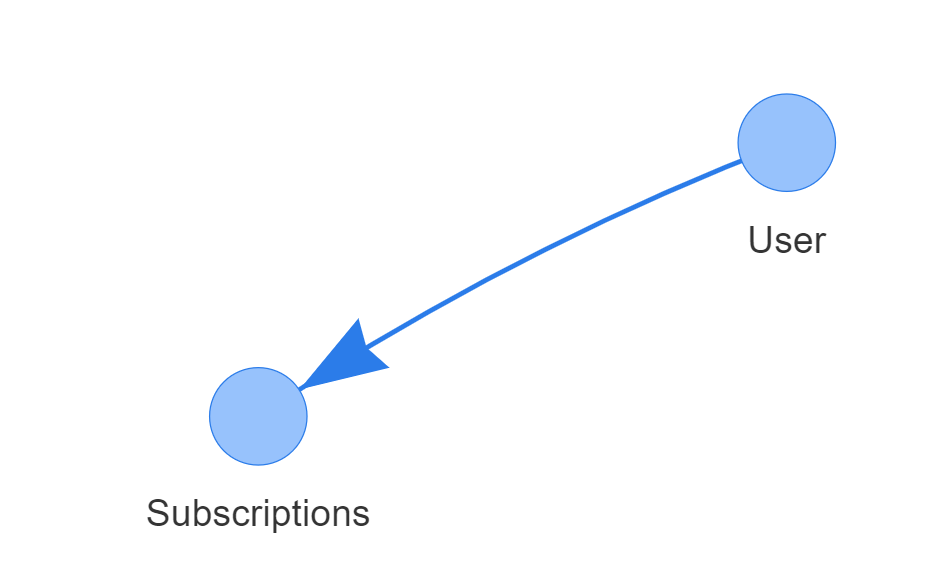A lightweight python library for implementing GraphQL on Relational DB Tables in few steps using python dicts. The library is built over strawberry-graphql for creating graphQL schema from dataclasses
Project description
GoRDB - GraphQL On Relational DB
A lightweight python library for implementing GraphQL on Relational DB Tables in few steps using python dicts. The library is built over strawberry-graphql for creating graphQL schema from dataclasses
Usage Example
GoRDB makes it easy to implement graph schema and graph queries like one given below on traditional Relational DBs.Example Graph query on Relational DB having User table and Subscriptions table implemented using GoRDB
{
User(filterStr:" @#ROWNUM#@ <5 ")
{
USERID,
USERNAME,
Subscriptions{
PRODUCTID
}
}
}

Installation Steps
Install using the following commandpip install GoRDB
Implementation Steps
Step-1:
Import GoRDB libraryfrom GoRDB import GoRDB
Step-2:
Initialize connection configs for your DB. Here config is shown for Oracle DB, You can set this for any RDB of your choiceimport cx_Oracle as orac
orac.init_oracle_client(lib_dir= "./instantclient_19_12")
import pickle
db=pickle.load(open("G:db_config.pickle","rb"))
username=db['username']
pwd=db['pwd']
db_uri=db['uri']
Step-3:
Create function which will receive an connection-id (string) and query (string) as arguments and return query results ( List of tuples) as returnconnection_pools_by_connection_id={}
connection_pools_by_connection_id['CUSTOMERDB'] = orac.SessionPool(username, pwd, db_uri,min = 5, max = 20, increment = 5, threaded = True,getmode = orac.SPOOL_ATTRVAL_WAIT)
def query_executor(connection_id,query_str):
global connection_pools_by_connection_id
custdb=connection_pools_by_connection_id[connection_id].acquire()
local_cursor=custdb.cursor()
local_cursor.execute(query_str)
query_result=local_cursor.fetchall()
return query_result
Step-4:
Add node definition for each node in your graph layer as dict in the format given below.
Nodes define the table in your Relational DB. Node alias is the node name which will be used in your Graph queries
Features define the columns in your RDB table. Feature type defines the column type(Default type: string)
Edges define the relation between on node to another and corresponding mapping keys. set many_mapping = True if you the edge define one-to-many relationship
Table connection id define the connection identifier which will be passed to query executor function
Query executor define the function which will be called to execute query.
Here for the example shown above we have 2 nodes.
USER_node_dict={
'node_alias':'User',
'tbl_name':'CUSTOMERDB.USER_TABLE',
'tbl_connection_id':'CUSTOMERDB',
'query_executor':query_executor,
'features':[
{'feature_alias':'USERID','feature_name_in_table':'USERID_SNO','feature_type':int},
{'feature_alias':'USERNAME','feature_name_in_table':'USERNAME'},
],
'edges':[
{'edge_alias':'Subscriptions','node_feature_alias':'USERID','foreign_node_alias':'Subscriptions','foreignNode_feature_alias':'SUBSCRIBERID','many_mapping':True}
]
}
SUBSCRIPTIONS_node_dict={
'node_alias':'Subscriptions',
'tbl_name':'CUSTOMERDB.SUBSCRIBER_PRODUCT_TABLE',
'tbl_connection_id':'CUSTOMERDB',
'query_executor':query_executor,
'features':[
{'feature_alias':'SUBSCRIBERID','feature_name_in_table':'SUBSCRIBERID_IDX'},
{'feature_alias':'PRODUCTID','feature_name_in_table':'PRODUCTID_IDX'},
],
'edges':[]
}
Step-5:
Build your GraphQL Schema by passing the list of node definitions dictschema,node_builds_compiled=GoRDB.build_scheme_from_node_dict([USER_node_dict,SUBSCRIPTIONS_node_dict])
Step-6:
Thats all! Execute your Schema, and await on the response. Now you have succesfully running Graph query engine on you RDB tables
Note: the filterstr corresponds to the "WHERE" part of your nomrmal SQL query. if you want to use some table columns which are not defined in your node definition dict you need to wrap them with ' #@' and '#@ ', but if the column is already defined in the node definition dict this is not need(for example 'USERID' used in the below query)
ding=schema.execute('{User(filterStr:" USERID > 5 and @#ROWNUM#@ <5 "){USERID,USERNAME,Subscriptions{PRODUCTID}}}')
print(await ding)
Other features
GoRDB have helper function called show_graph which can be used to see the network diagram of your Schema
GoRDB.show_graph([USER_node_dict,SUBSCRIPTIONS_node_dict])
Project details
Download files
Download the file for your platform. If you're not sure which to choose, learn more about installing packages.
Source Distribution
Built Distribution
File details
Details for the file GoRDB-6.3.tar.gz.
File metadata
- Download URL: GoRDB-6.3.tar.gz
- Upload date:
- Size: 21.4 kB
- Tags: Source
- Uploaded using Trusted Publishing? No
- Uploaded via: twine/3.4.2 importlib_metadata/4.8.1 pkginfo/1.6.1 requests/2.24.0 requests-toolbelt/0.9.1 tqdm/4.50.2 CPython/3.8.5
File hashes
| Algorithm | Hash digest | |
|---|---|---|
| SHA256 |
9eb6c66efaa1998d424fa872a5c00036ae4371260853166adc515a4c4c8f98d3
|
|
| MD5 |
fed0fa4c05e60b961b7b75fa2cf1196e
|
|
| BLAKE2b-256 |
69709a1f4b60225abc2e792ca0b36caf4a2c7c28342d7c41fcfcc9923d211c2f
|
File details
Details for the file GoRDB-6.3-py3-none-any.whl.
File metadata
- Download URL: GoRDB-6.3-py3-none-any.whl
- Upload date:
- Size: 19.3 kB
- Tags: Python 3
- Uploaded using Trusted Publishing? No
- Uploaded via: twine/3.4.2 importlib_metadata/4.8.1 pkginfo/1.6.1 requests/2.24.0 requests-toolbelt/0.9.1 tqdm/4.50.2 CPython/3.8.5
File hashes
| Algorithm | Hash digest | |
|---|---|---|
| SHA256 |
7a067ec55904c0bd9cec686b8acffe1820f8c9e30f0e8ce657f1f03365815a72
|
|
| MD5 |
7e103f8e376ea38766ea76be08ea8751
|
|
| BLAKE2b-256 |
1b3d710c5b5f7559be3fe96329a6f8a3448bdc9baded9cb5cf68cd291eafe80f
|











